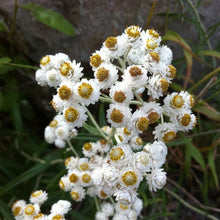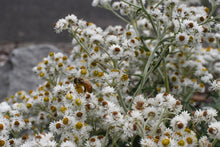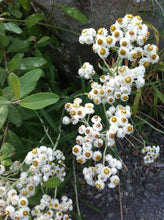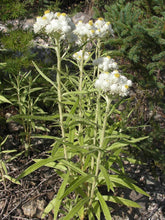
Anaphalis margaritacea
Pearly everlasting is a lovely, white-flowering perennial that attracts pollinators and butterflies. Its fuzzy, silvery foliage emerges each spring and flaunts abundant blooms from early summer into fall, making it an important late season pollinator plant. The stems and flowers hold up nicely throughout the season and can be used in dried floral arrangements or to simply add structure and beauty to a sleep winter garden.
- Plant type/canopy layer: deciduous, perennial, herbaceous plant
- Size at maturity: 1-3' tall, 18-24" wide
- Light requirements: full to part sun
- Moisture requirements: moist to dry soil
- Bloom time: May - September
- Growth rate/ease: fast growing, easy to grow
- Wildlife support: flowers attract and provide nectar to adult butterflies, bees and other insect pollinators; overall plant attracts and supports beneficial and other pest eating insects and is a caterpillar host plant and larval food source for native butterflies and moths. Specifically, it is the host plant and provides nectar for painted lady and skipper butterflies.
- Native habitat/range: common growing in exposed habitat types including meadows, grassy hillsides, disturbed sites, beaches, clearcuts, streambanks, rock outcrops, forest openings, and roadsides, from sea level to 2500m, across a wide range of North America, including most states except the south-eastern ones. Portland Plant List - yes.
- Special features & uses: late season pollinator favorite; medicinal; landscape uses include rock gardens, pollinator gardens and erosion control.
Gardening with Pearly Everlasting: This is a carefree plant that grows effortlessly in most to full sun areas with good drainage. Though it prefers moist soil, it can tolerate drought once established and is perfectly happy with low-nutrients. It provides excellent erosion control, making it a perfect choice for bare areas that receive little human attention. In gardens that receive lots of love and care (i.e. supplemental moisture and rich soils), it can be an aggressive spreader.
Photo Credit 1, 3: Nikkie West, Sparrowhawk Native Plants
Photo Credit 2: Tara Lemezis
Photo Credit 4: "Anaphalis margaritacea" by peupleloup is licensed under CC BY-SA 2.0







